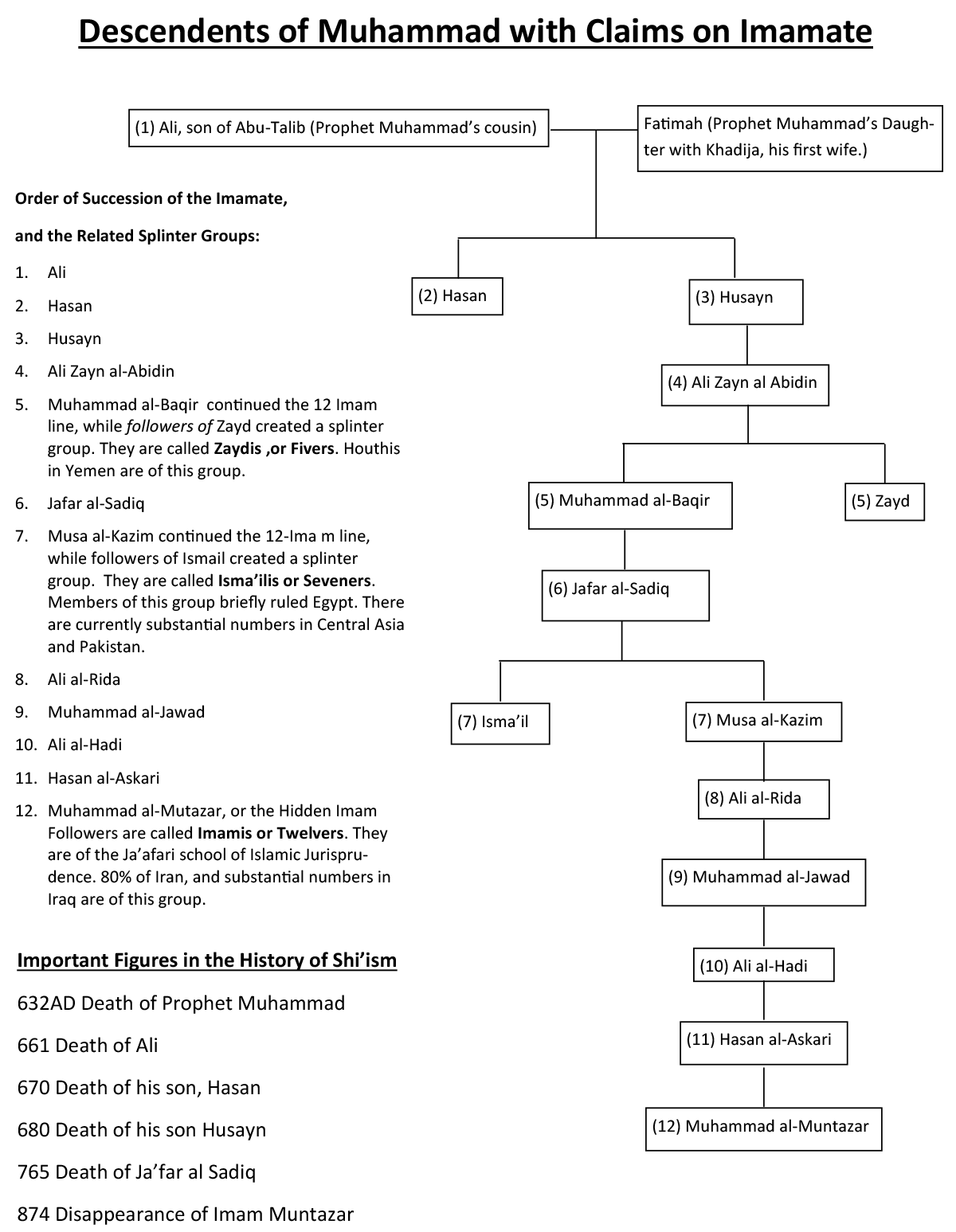Chapter Two: Faith and Religious Identity
Shi’ism
The word Shi‘i, also referred to as Shi‘ite, means “one who is a partisan,” or “supporter”, in Arabic. It is in reference to ‘Ali, prophet Muhammad’s cousin and son-in-law, who many considered his rightful successor. This partisanship dates back to just after the death of the prophet in 632, C.E., when there was disagreement over who should be his successor. A meeting was convened, and the prophet’s friend Abu Bakr was chosen by the group. Those who agree with that decision call themselves followers of the traditions, or Sunna, of Islam. They are thus called Sunnis. The differences between Shi‘i and Sunni Muslims are primarily focused on this history, and not as much on doctrine. There are a lot of theological similarities between Shi‘is and Sunnis – more than one might expect, considering their historical disagreements, and they are as follows:
- Both follow the Five Pillars.
- The Qur’an is the same, word for word.
- Prayer is the same; i.e., times of day, same direction, etc. (Some minor differences are that Sunnis fold their arms when they pray, while Shi’i let them hang. Some Shi‘i Muadhans, those who call the community to prayer, add the phrase ‘Ali Wali Ullah, or ‘Ali is the Viceroy of God, at the end of Adhan, or the call to prayer.)
Shi’i Leadership Geneology:

Shi‘is have also been called Fatimis, or Fatimids (during their reign in Egypt), because they regard the lineage through prophet Muhammad’s daughter, Fatima who married ‘Ali, to be the valid transfer of power. They do not consider the first three successors of the prophet recognized by Sunnis to be valid. This is their fundamental disagreement with Sunni Muslims.
Shi’is emphasize the value of lineage and family ties over the consensus of a large number of Muslims after the Prophet’s death. This value is reflected among the Ja‘afari Shi‘i, who follow a tradition of wearing a black turban to indicate one’s lineage traces back to the Prophet. Both Sunnis and Shi‘is respect the descendants of the Prophet, however, and call them noble, or Sayyids or Sherifs, in Arabic.
The political doctrine of the Shi‘i recognizes the institution of the Imamate, or Imama, as head of state or community. According to this doctrine, the leader of a Muslim community, or the Imam, must be a direct descendent of Prophet Muhammad through his daughter, Fatima, and son-in-law, ‘Ali, as the head of government. On the other hand, the political doctrine of the Sunni is the Caliphate, or Khilafa, as the head. This reflects the political process that occurred after the death of the Prophet in 632 to select the leader by traditional tribal meeting, or shura. A shura was convened, and Abu Bakr was chosen by the participants of that meeting through bay‘a, which means group decision by consensus.
Eventually, ‘Ali was elected leader, but he was killed by the hand of a secessionist, or Khariji, rebel in 661. After that time, the Sunni Muslim community reverted to dynastic rule, the prior paradigm of the Arab communities of Mekka. Mu‘awiyya established the superiority of his clan, the ‘Umayyids, and they ruled the umma, or significant portions of it, for another 370 years. Thus, the Caliphate became more like the institution of monarchy thereafter.
Hussayn, ‘Ali’s grandson, made a claim as the rightful leader, finally dying at the Battle of Karbala in 680. After that, the lineage continued, with claims on the Imamate, but there were contestations (see chart, p.37). Two of Ja‘afar’s sons claimed to be Imams – one was Isma‘il. The followers of him are the Isma‘ilis, or the Seveners, who reside in Pakistan, North Africa, Central Asia, including North East Afghanistan, and the mountains of Tajikistan. They recognize a living Imam, Karim Ali Khan, or Karim Agha Khan. Thus, in Afghanistan and other Central and South Asian countries, they are also sometimes called Aghakhanis.
In 874 Muntazar, the 12th Imam, disappeared. His followers, the Twelvers, consider him to be the rightful Imam, and expect he will return. Because of this they are often called Imami Shi‘i. In the absence of the 12th Imam, Shi‘i argue that their jurist scholars, or Mujtahids, should fill the position of Imam. This would be a temporary form of leadership until the reappearance of the 12th Imam.
